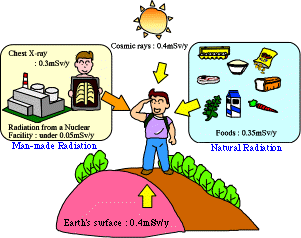|
|
|
|
 |
Environmental radiation monitoring stations (such as the one shown in the picture) are located around and outside the site boundary of the Monju and Fugen reactors.These stations operate continuously around-the-clock making measurements of airborne activity. The standard unit of radiation dose rate used in environmental monitoring is nGy/h (nanograys per hour). One gray is the absorbed dose of ionizing radiation,corresponding to one joule per kilogram - one nanogray is one billionth of a gray.
The measured dose readings are relayed to the main control rooms at Monju and Fugen, and given to the 12 local governments in Fukui Prefecture. via Fukui Prefectual Environmental Radiation Research and Monitoring Center.
|
 Monitoring Station at Echizenkuriya
Monitoring Station at Echizenkuriya
|
 |
In our every day lives, we are constantly receiving radiation. The amount of radiation received by a person's body is expressed in units of mSv (milliSeiverts). This radiation comes from cosmic rays from space, from earth, and from natural radioactive substances in food. This radiation amounts to about 1.1 mSv per person per year. (Excluding radiation from naturally occurring radon, 1.3mSv/y).
|

|
Besides this, radiation is received from other sources such as from hospital x-ray examinations and from nuclear power plant operations. This type of radiation is called man-made radiation.
|
 |
How much radiation we receive depends upon where we are. For example, in Japan, the amount of radiation in the Kansai area is generally higher than in the Kanto area. This is due to differences in the earth's composition.
If a person were to move from Tokyo to Osaka, that person would come to receive 0.17mSv more radiation per year, however this would have absolutely no ill effects. Nuclear power plants have established a goal of releasing no more than 0.05 mSv per year; this is lower than what would be obtained by moving from Tokyo to Osaka.
|

|
Also, the amount of radiation received from cosmic rays depends upon elevation. For example, if a person were to stand on the peak of Mt. Fuji, that person would receive five times more radiation than when standing at ground level.
|
|